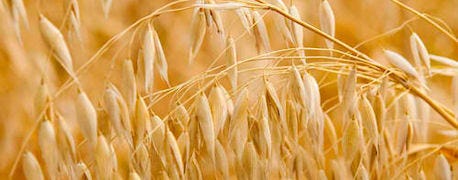July 2, 2013

Rainy weather in some parts of the country is holding back hay-making, leading to a real concern for some farmers who wonder what they will get a hold of to supplement a lack of forages.
In the eastern Corn Belt, for example, some producers are choosing to combat lower hay inventories by double-cropping oats with wheat for their beef rations.
With a harvest date from early to mid-July in parts of the Corn Belt, wheat makes an ideal companion for oats, which have a recommended final planting date of Aug. 1, said Ohio State University Extension program assistant Stan Smith.

Midwestern beef producers having trouble harvesting hay due to rain; now turning to double cropping wheat with oats
Hay inventories on May 1 in his state are down 55% compared to the same time last year and at their lowest point since 1950.
Smith said oats commonly yield 3 tons of dry matter per acre, which is as productive as many traditional forages but only require one cutting. Regardless the planting date or variety, no-tilled seeding rates from 80 to 100 pounds of oats have consistently resulted in optimum forage yields, he said.
"We can grow oats as a second harvest after wheat and grow what's equivalent to yields that we're getting from traditional mixed hay fields," Smith said. "We can achieve that in a short time, 75 days plus or minus, doing it in one cutting so you can save time and money by not using multiple harvesting operations."
But oats can be planted in combination with other crops, Frank Wardynski of Michigan State University Extension points out.
"Oats can also be planted in combination with peas to produce high quality feed," Wardynski said. "Other small grains such as spring wheat, triticale and barley have also been successfully planted with peas for high quality forage production."
~~~PAGE_BREAK_HERE~~~
Another option is to plant a forage type soybean. Though research utilizing soybeans as forage is very limited, a feed analysis indicates protein and fiber values are nearly comparable to alfalfa, with protein at 18-20%, NDF 38-46%, and ADF 28-34%.
Soybeans that are weather damaged or frozen before reaching maturity can be useful feed for beef cows, Wardynski said, but will not produce forage similar in quality to alfalfa. Soybeans should be harvested just before the R7 stage which occurs when one pod of the main stem contains mature seeds.
Also pay attention to the limited list of pesticides approved for use on soybeans destined to be harvested for livestock feed, Wardynski said.
Special considerations for oats
If producers are interested in oats specifically, Smith said growers should apply glyphosate prior to planting and apply 40-50 pounds of nitrogen per acre for optimum growing. August-planted oats are ready 60-75 after planting, while July-planted oats are ready 50-60 days after planting.
Oats harvested 50 to 60 days after planting and while still in the boot stage of maturity may offer some regrowth that could be grazed. While strip grazing is the preferred method of harvest, Smith said growers have other options including baling and ensiling.
Baling is a challenge considering that oats dry only about half as fast as grass hay. In some cases, oats are taking nearly a week after being cut before they are dry enough to properly wet-wrap and ensile, Smith said. Dropping them on wet soils doesn't enhance the drying or curing process.
*Baling. Let the oats stand until they freeze. When a few days after dry frozen weather arrives, mow them, rake them and bale them quickly after they've essentially dried and cured while standing.
*Wet-wrapping. Using an in-line bale wrapper/tuber is less expensive per ton than individually wrapped bales if the equipment is available locally, but unless done properly might result in more storage loss than wet-wrapping individual bales.
*Chopping and ensiling. This offers advantages over baling or wet-wrapping. Chopping and ensiling into either a permanent structure or bags is also likely less expensive than wet-wrapping individual bales.
News sources: MSU, OSU
You May Also Like




